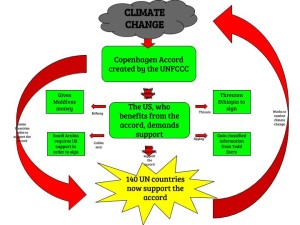After reading and sifting through one of the most difficult and poorly written articles I have ever seen, I have complied the above diagram. I chose to focus on the direct correlation between the initial instigator of the Copenhagen accord and its current end result. Climate change and the need to reduce current greenhouse gas emissions (as well as move forward (away) from the Kyoto accord was the primary motivating factor in establishing the Copenhagen accord. As the United States stood to benefit from the accord in a large way, many “sneaky and underhanded” attempts were made to gain cooperation from several countries. Through extortion, bribery, spying and “behind closed doors” types of deals, the United States secured support of the accord from several United Nations countries including Ethiopia, Saudi Arabia and Maldives. In total, we now have 140 united nations countries supporting the Copenhagen accord. Although not the most ideal accord in regards to an aggressive approach to reducing current green house gas emissions, the net result will likely help reduce current levels (albeit at easy, “comfortable” levels) and help to curtail the larger issue of climate change.
This is a very slippery slope on the road to global climate change, While it may seem easy to justify the ends on the benefit of the means, the end result on this particular accord does little to actually benefit the end result. The Copenhagen accord was written and worded to allow compliance with self set goals that individual nations place on themselves. There is no enforced compliance and no authority to report to. I readily admit that I take a largely ecocentric view on this and most other topics. That being said, while I disapprove of the corrupt and underhanded politics exercised by the United States in its attempts to bolster support for the Copenhagen accord, I like seeing any forward progress in the worlds approach to curtailing green house gas emissions. According to Johan Rockstrom in his Ted talk video “Let the Environment Guide our Development”, he offers strong scientific support for needing an immediate, aggressive reform to our current green house gas emission levels. There would need to be worldwide compliance and drastic reduction over the course of the next 40 years before reaching a potential planetary boundary for climate change. The Copenhagen accord comes no where close to these needs, but, it is a step in the right direction. I also believe that there is no inherent wrong in making the cables publicly available. I believe that the world needs to fully understand the potentially catastrophic situation that we are in, and how world governments are playing sneaky politics and taking a less than serious approach in dealing with this issue. We need to demand for more incentives and policies in promoting and establishing an aggressive “green” power plan using renewable energy sources that have zero or close to zero green house gas emissions. I understand tat this may require taking a few steps backwards, but necessity is the mother of invention. We will move forward with new innovations and methods in using clean energy if we are forced to remove carbon based fuel sources from the equation.


Hi Ben, my name is Sabrina and you can find my blog post at http://geog030.dutton.psu.edu/2016/04/05/module-9-climate-change-2/ .
I have not seen any diagram quite like yours; it looks great! Anyway, I appreciate how you recognized the efforts and success of the Copenhagen Accord while also showing that those efforts were not nearly enough for the world to completely understand how big of an issue climate change is. Along side of that, you mentioned how there was nothing wrong with making the cables available, and after reading a few blog posts and debating it myself I would have to agree with you, as it gives the world another opportunity to see how big of a deal this is.
Although I did not mention the TED talk in my blog post you used it as a great way to connect to how we need an “immediate, aggressive reform to our current greenhouse gas emission levels” which was a great addition to your blog post.
WOW Ben, I just love your diagram, it may be my favorite one I’ve seen yet. Its so colorful and contains just enough detail to sum up the main points of the article. Very well organized! I was also very interested in your feedback to the WikiLeak article. You made some points that I was not aware of such as the Ted Talk with Johan Rockstrom. You bring up a lot of great points in the moving forward such as demanding more incentive and policies in promoting and establishing the plan using renewable energy source. You seem very educated on the subject of climate change and very passionate about the moving forward with it. Great job and very well written.If you’d like to check out my blog you can find it at http://sites.psu.edu/geog30/2016/04/05/module-9-rachael-donnelly/